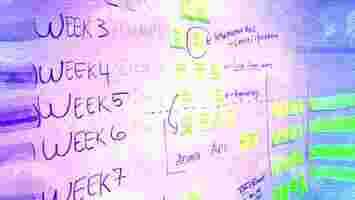You need to rethink your customer experience for 2021 — here’s how I did it
As the CEO of an SME business, 2020 wasn’t exactly smooth sailing. The pandemic left us feeling like we’d had the light switched off and were spun around until we were dizzy. It wasn’t easy, but it looks like we survived. We weren’t the only ones, and most of our peers obviously felt the same trauma.

As a B2B business, everybody found themselves in the same boat rocking back and forth. This meant that the way we communicated with, sold to, and dealt with our customers changed. The year 2020 was one that changed B2B business forever. It required the adoption of new approaches and techniques to get by.
I want to share the same customer experience approaches and techniques that I’ll be taking into 2021 with my community.
The success of customers came first
In 2020, it became clear that customer retention had to take priority over customer acquisition. We realized that businesses would minimize their costs, meaning they might want to stop using our software.
There’s no point in acquiring new customers slower than you’re losing them, so we consolidated and leveled up our Customer Success (CS) program and relied on that as we plunged into the unknown.
It’s a strategy that involves being proactive to customer problems, instead of reactive. It’s all about getting to know your customers and their product so profoundly, that you can reliably give them the very best of your product for their exact niche and need.
I could go on about CS strategies until the cows come home. But in the interest of your interest, I’ll break it down into some smaller points.
1. Onboard and activate customers on an individual basis
Before any one-to-one conversation with a new customer, our CS Team does their research. They find out which industry the customer is in, which problems our product should solve, and which processes and workflows they employ that our product can fit in.
With this information, they can have an educated first meeting, skip the unnecessary questions, and get into the meat of what our product can do for them.
2. A perpetual education and re-education of customers
CS revolves around shared education. After educating yourself, educate your customers… and never stop. Apart from the newsletter and in-product notifications alongside significant updates and releases, we run live webinars, walk through the features we have added or improved during the assessment calls.
Furthermore, we continuously produce educational and pre-boarding content on our blog such as guides, ebooks, cheat sheets, and checklists.
3. Stay in touch
We’re proactive. We don’t wait for a customer to contact us with a problem, we set regularly scheduled calls to check in on them and their experience of our product. We’re always adding features and tweaking our system. If that’s relevant to a specific customer, we always let them know so they can get the most out of it.
Above all, a successful CS strategy requires complete internal cooperation of the business that is practicing it. It needs sales and marketing singing off the same hymn sheet, using the same data, and putting out the same message. We do not doubt that our Customer Success strategy was one of the main reasons we survived this year.
Personalization needed to go further
Let’s bust the myth that calling somebody by their name in the subject line increases their engagement with an email.
It might be valid to some extent, but in 2020 literally every brand that you could name is doing it. It’s no longer impressive. If anything, it’s the bare minimum. In 2021, we need to go further in our personalization efforts. This all starts with immediate lead enrichment upon a user’s registration with a brand.
In my opinion, the definition of personalization got lost when Mail Merge was invented. In business, personalization should mean giving your brand a personality; humanizing it.
It means implementing a conversational customer experience and aggregating all communication channels so a customer feels a seamless, personalized brand experience, with no disconnect between the different arms of it. As the pandemic adds to even more uncertainty about buying power of leads, this only becomes more important.
1. Conversational Customer Experience (CCE)
A brand providing CCE is one that provides continuous support and guidance and support for customers on an individual basis. It opens up a two-way channel of communication between a brand and a customer, ensuring a smoother path to customer success.
We provide timely, relevant, and helpful information on request, and our relationships with our customers consolidate and grow.
2. Omni-channel, personalized communication
We try to meet our customers where they are, and I appreciate that this sounds somewhat vague at first. Simply put, our different buyers have different preferences.
This means we can’t expect the same approach to work for everybody. Ideally, we should be able to provide different, preferred channels without losing any information; a seamless buying experience. In 2021, we plan to experiment with even more promotional, distribution, and purchase channels.
We all needed each other
One of our biggest successes of 2020 was our user community, which was set up as a direct response to the coronavirus pandemic. It was initially set up as a simple Facebook page, titled ‘ Crisis-Proof Community ’, but the success of it meant we coded a section into our product as a new home. Eventually, it just became a general user community, rather than being focussed on pandemic response.
Our community empowered us in so many different ways, giving us benefits that we never planned for.
It lifted the weight off our Customer Success Team’s shoulders , simply because they had to deal with fewer queries and calls for the more simple, more common questions they receive.
It gave us more visibility on Facebook because we would pop up on the timeline of our users’ friends. Now the Facebook group redirects users to the native group.
We found a new source of product development leads , meaning we could hone our SaaS product. We could gauge how much a particular feature was wanted simply by the number of people who engage with the request for it.
It added more personality to our brand because we could reply from our individual Facebook accounts on different user posts. It gave us another, specific channel upon which to share content.
The pandemic drove both brands and consumers into deeper relationships with technology. We’ve been able to take advantage of that by bringing our whole customer base; people who share the same values, interests, and challenges together under one URL.
A little bit of humanity goes a long way
The last point I’ll make is a little bit more common sense. Above everything else in 2020, we understood just how nice it is to be nice. Our users, the exact ones that gave me this platform to share my advice, needed us.
They required us to show compassion and empathy to their situation because not everybody was able to weather the storm to the same end. A chatbot is suitable for solving minor problems, directing a customer to the right department… but it’s no shoulder to cry on.
Now, it’s more important than ever to close feedback loops promptly and satisfactorily to our customers. In 2020, our customers needed us more than ever, they needed our product — not only to drive them to success, but to help them keep their heads above water.
Regardless of whether we were able to implement a request or not, we listened and considered each individual one. If the request was related to their subscription payment, we’d trust our front-line employees to offer the correct discount, payment holiday, or additional service.
In return, we were able to ask our customers for something in return.
A review on dedicated platforms like G2 or Capterra.
A recommendation for our product to partners and friends.
To host a partner webinar if you have an audience overlap.
A success story to share on our social media or a blog.
Going forward in 2021, we will continue to be flexible for our customers in the hope that our customers can be flexible for us. A business can get bogged down in bad times at any time, not just during the pandemic. Sometimes it’s easy to get lost in the suit-and-tie of it all; to lose faces behind company logos.
Overall, we’re grateful that we were fortunate as a SaaS business. We’re blessed to be online, with the coronavirus’s impact kept to a minimum. We’re blessed to have been able to learn from it, rather than to be beaten by it. I’m blessed to be able to share the lessons I’ve learned from this year with my fellow business community. After all, as I said in the article… we need each other.
I hereby proclaim 2021 to be normal .
3 simple website tweaks to impress your customers

Hey snoozy Susan, here’s how to stop falling asleep at work
It’s 3pm on a Friday and you’ve had enough. Or maybe it’s just after 9am on a Monday and you’re struggling to get started, or even 12pm on a Tuesday and you’re falling asleep.

Sound familiar? If so, you’re probably used to the overwhelming struggle that is trying to stay awake at your desk when you really just want to fall asleep.
If it’s any consolation, you’re far from being alone. That’s why I’ve put together these few pointers to help you stay engaged, active, and awake while you’re at work.
Get your steps in
Getting your morning routine right will undoubtedly set you up for a productive day and stop you from falling asleep.
Morning exercise is a good way of waking up your body and mind. If you can, go for a walk before you start work and get some fresh air.
You’ll feel more awake, and what’s even better, you’ll get your dreaded workout out of the way first thing.
Coffee isn’t the answer
Coffee is wonderful, it really is.
A good cup of the stuff can turn the worst of days into the best of days — but you shouldn’t abuse it.
If you’re going to be friends with caffeine, make sure you limit your intake because too much of it can leave you feeling lethargic.
I would recommend having one, or two (at most) cups of in the morning and sticking to water for the rest of the day, which brings me on to my next point.
Stay hydrated
Water really is your best friend , especially when it comes to staying awake.
Dehydration can lead to fatigue because it impacts the flow of oxygen to the brain and can cause your heart to work harder to pump oxygen to all your organs , thus making you more tired and less alert.
Water can also help reduce stress . In fact, studies have show that dehydration can also lead to higher cortisol levels — the stress hormone — making it even harder to deal with daily problems.
You’ll need daylight
Natural daylight — or the lack of it — can have a huge impact on how you feel at work.
I used to work in a windowless office in a London co-working space and I’d find myself getting increasingly sleepy and restless throughout the day. I eventually realized this was mostly due to the lack of natural light — and it seems my conclusion wasn’t unfounded.
A study conducted by a US professor found that workers in day lit office environments reported an 84% drop in symptoms of eyestrain, headaches, and blurred vision symptoms all of which can detract from productivity and potentially lead to sleepiness.
Snack away
I don’t know about you but I used to experience an early afternoon drop in productivity and would start to fall asleep, particularly in the colder, drearier months — and then I started snacking.
It turns out this afternoon slump was probably caused by a drop in blood glucose levels and the good news is that I managed to solve this problem by keeping several healthy snacks within arm ’s reach or just a short walk away.
Time yourself
Whether you’re working on an ongoing project or you want to tend to your overflowing inbox , own your productivity and hold yourself accountable by timing yourself.
Here’ s a familiar scenario: You need to prepare a report by the end of the day but it’ s 4PM and you’re struggling to stay awake. Stop what you’re doing, take a moment, breathe in, and set a timer on your phone . Give yourself a deadline and motivate yourself with the possibility of a nap once your work is submitted.
Get the hard stuff out of the way
Only you know when you feel more awake, so keep this at the forefront of your mind when you’re planning your day.
If you feel less sleepy in the morning, take care of the hardest, most boring tasks then and keep the fun stuff for later. If you’re more alert in the afternoon or evening, then save the most menial tasks until then.
There’ s no hard science and if you’re fortunate enough to work somewhere that offers flexible working , you should use this to your advantage.
Let music be the food of love productivity
Lastly, but by no means least, I have to be honest with you: I can’t do anything without listening to music and while my taste may be questionable, that’s besides the point.
If you’re working from home or are lucky enough to have your own private office , why not sing along?
It’ll perk you up, you won’t fall asleep, and if you’re as bad a singer as I am, well, no one will hear you!